Other Links
<Editorial Board
- Editor - Bill Kenny
- London Editor-Melanie Eskenazi
- Founder - Len Mullenger
Google Site Search
SEEN
AND HEARD INTERNATIONAL OPERA REVIEW
Richard
Wagner, Rienzi:
(New
Production) Soloists,
Chorus of Leipzig Oper and the Gewandhaus Orchestra conducted
by Axel Kober, Leipzig Oper 16.11. 2007 (JPr)
Leipzig in November before the Christmas festivities: grey, bleak,
snowy, industrial, a mix of the quaintly medieval with the austere
relics of Communism and the high-rise buildings of post-Berlin
Wall regeneration. All these preconceived ideas hit their target
but the city was also full of some of the friendliest, smiley and
helpful people I have ever found in Germany, regardless of whether
they thought I was German or Johnny-Foreigner.
Wagner was actually born in Leipzig, but because of these twentieth-century
associations little is made of the fact. The site of his birth is almost
a state-secret; the address is absent from most city guides
despite the fact that when you arrive there a plaque marks
the place where the Wagner house stood until 1886.
Although at the birth place, typical East European
concrete blocks of flats are currently being demolished, the local Wagner Society is
trying to repatriate the composer
with the slogan ‘Richard ist Leipziger…’ in time for the 200th
anniversary of his birth in 2013.
Other differences in Rienzi from later works include the use of a
non-mythical
historical topic for the opera. And instead of providing his own
libretto, Wagner adapted the plot from Edward Bulwer-Lytton’s
nineteenth-century novel of the same name. In the story, Rienzi, proclaims himself
tribune of Rome, faces assassination plots from noblemen led
by Orsini and Colonna, whose son Adriano loves Rienzi's sister
Irene. After his opponents are killed, Rienzi is excommunicated by
papal allies of Colonna and is abandoned by everyone except Irene, who
remains loyal to the end. As Rienzi and his sister are stoned by the
people, Adriano tries to rescue Irene but all three are killed
when
the burning Capitol building collapses. Afterwards the nobles
attack the people.
Even at this length Rienzi has occasional longueurs
when the brass section is required to blow too long and loud,
where choruses repeat themselves or we
hear Rienzi’s battle-cry ‘Santo spirito
cavaliere!’ more times than
necessary. The melodic inspiration in the accompaniment
also sags from time to time with fare too much Verdian ‘rum-ti-tum’ but
on the plus side there is also more inspired music than Wagner
himself seems to have acknowledged. Examples arethe fine duet
‘Mein
Bruder/Irene, meine Heldenschwester!' between Rienzi and his
sister in the last act andhis sublime prayer ‘Allmächt’ger
Vater’.
At the start of Act III, Rienzi strides in full
regalia
down a walkway at the back of the stage to be surrounded by Rome
in miniature: St Paul’s Basilica, the Colosseum, Castel
Sant’Angelo, and Capitol are among the sites shown. Rienzi
dons a
red robe and later on, his vanity knows no bounds when he has make-up
applied before addressing the Roman people. We witness state-sponsored terror and torture by the end of the act and
Colonna, Adriano’s father, has become one of the victims. By Act
IV - when Rienzi is excommunicated by the Papal Legate (‘Du aber
bist verflucht’) - musically we are very much in the world of the
soon-to-be composed Tannhäuser. For Act V all we have left
on a deserted stage, is the small version of the Capitol which
eventually catches fire to signal Rienzi’s
downfall. At the end there is (silent) gunfire and a horrible
massacre of the people of Rome dated 1354. The model building
incidentally, was
still alight during the curtain calls : nobody observes
‘Health and Safety’ rules like we do in the UK.
Nicolas Joël (director)
Andreas Reinhardt (sets and costumes)
Michael Röger (lighting design)
Cast:
Stefan Vinke (Rienzi)
Marika Schönberg (Irene)
Pavel Kudinov (Colonna)
Elena Zhidkova (Adriano)
Jürgen Kurth (Orsini)
Christopher Robertson (Raimondo)
Martin Petzold (Baroncelli)
Thomas Oertel-Gormanns (Cecco)
Gabriela Scherer (Friedensbote)
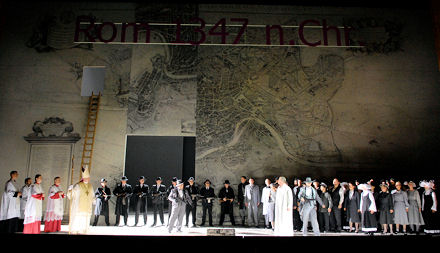
Act I
The Leipzig ‘Neues Theater’ dated back to 1868 but was destroyed
in an air raid in 1943. It reopened in 1960, but as someone
remarked to me recently, European opera houses often find any excuse for
a ‘grand reopening.’ In this case it seems that the theatre has been undergoing
progressive renovation over recent years and has finally got round
to doing up the foyers, cloakrooms and toilets. This
generated
November 16th's gala, complete with a new production
of Wagner’s rarely performed
Rienzi, an event promoted by adverts on nearly every
street corner.
Adolf Hitler apparently first saw Rienzi in Linz with
August Kubizek, a friend of his youth, sometime in the early 1900s.
Without much money in their pockets, Hitler and Kubizek would go
to the opera house early, to find the best places in the
standing-room-only section and they saw all of
Wagner's works while leaning against the columns of the old Linz
Opera House. Kubizek wrote that of all of the operas
they saw there, Rienzi took an almost mystical hold on the young Adolf.
After seeing the
performance and seeming to go into a trancelike state, for the
first time in his life Hitler talked profusely
about politics. It is because of this account - and the indiscretions of some of
Wagner’s writings when times were hard for him - that Wagner has
become so associated with the undoubted horrors of World
War II.
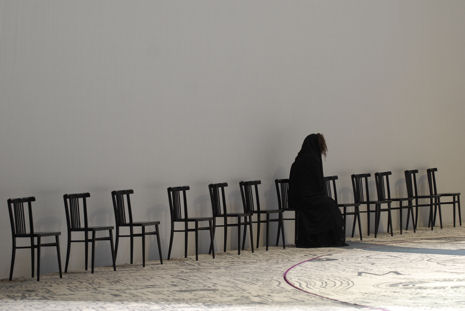
Act II
The manuscript score of Rienzi - which last belonged to
Hitler - is now missing. The longest version we now have has been
reconstructed from Wagner's original composition draft and the 1844 vocal
score for some Hamburg performances so that almost
one-fifth of the current version has been reconstructed. The 1844
Hamburg version presumably contained cuts from the missing
Dresden version made for the successful 1842 première which Wagner
himself found too long at six hours including the intervals.
Bayreuth refuses to perform this work, Wagner's third opera, and the
composer
distanced himself from it later in life, even though the opera had more performances during his lifetime than all of his other
works. This is fairly common occurrence among composers: Puccini
and Verdi rejected many of their early operas, such as Le Villi,
Edgar, and Il Corsaro. Even so, the Wagner of Der
fliegende Holländer and Tannhäuser has undoubted
roots in Rienzi and this is blatantly detectable in
musical ideas recycled in the later works.
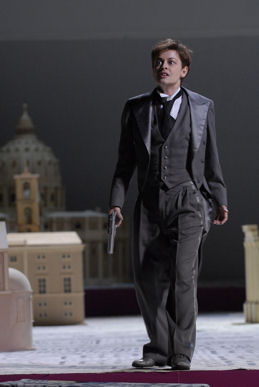
Act III - Elena Zhidkova as Adriano
At this time Wagner was trying for an anticipated Parisian
audience to ‘out-Meyerbeer’ Meyerbeer and was not being
true to his musical instincts. Additionally the vocal
lines are merely supported
by the orchestra which is not intrinsic to telling the story
by continually employing the leitmotifs that Wagner would use
later. Wagner voluntarily included a 40-minute
ballet in the score without being compelled to do so by the
Paris Opéra as he was with Tannhäuser. The
pantomime/ballet is divided into almost equal sections, telling the story of the rape of Lucretia
with a second part added that
allegorizes the union of classical and modern Rome. The Schott
score used in Leipzig contained a little over three hours of music:
it kept
the five acts intact but had some scenes shortened and offered only the briefest
account of the ballet music. The result was that Act I
lasted about an hour, Acts II, III and IV about 45 minutes each
and Act V about twenty minutes.
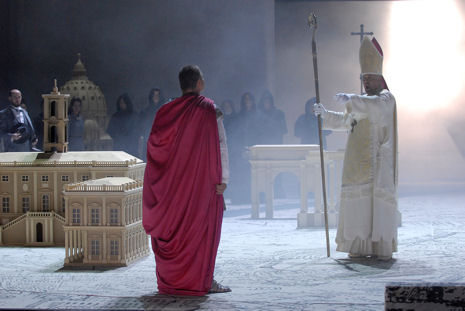
Act IV
So what about the production? I
predicted before opening the programme that
there would be men in grey suits, machine guns, and multiple dining
chairs ranged round the margins of the set, which would be thrown
over at least once. All these boxes were ticked in a staging of
typical Wagnerian Euro-blandness by Nicolas Joël who is soon to take up the
post of
Director of
the Opéra National de Paris. It was
completely inoffensive because there was not a single thing
that I didn't
anticipate.
Act I was pretty static; almost like a staged concert
performance set against a drop curtain showing an
engraving of 1347's
Rome. Apart from the papal legate in his fine robes, grey is the
predominant colourway until Rienzi dons shining armour for ‘Sei
frei, sei jeder Römer frei!’ In Act II there were three plain
grey walls and a spectacular chandelier, Rienzi’s goons
with guns and his supporters dressed in tails sitting on the chairs and smoking. The
only splash of colour is Rienzi’s
red-bedecked podium and by ‘ich, der Tribun’ Rienzi begins to show signs
of being power-mad and out of step with his former supporters. Nicolas Joël’s
simple moral is that dictators have become megalomaniacs throughout
history.
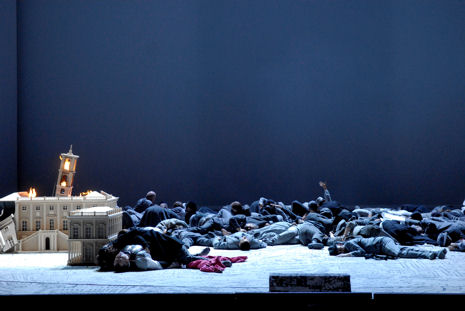
Act V
The cast was fairly strong rather than sensational. Stefan Vince
(Rienzi) had a stolid if not very
Axel Kober knew how to shape the music and began with
an unhurried Overture that anticipated better music to come than
we would actually hear. He was very responsive to his singers and
never drowned them - always a risk in this music. But because of his
likely close involvement in
preparing the score he was completely at ease with it, well aware
of the points at which dangerous
tedious
moments could occur and mainly he overcame these well. The
off-stage music was nicely balanced and there was a perfect
ensemble between this, the principal singers, the excellent
enhanced chorus of Leipzig Opera (directed by Sören Eckhoff) and
the wonderful musicians of the Gewandhaus Orchestra. It is never a
Rienzi conductor’s fault that some choruses and marches
seem over-insistent and loud: at this stage in his career Wagner
probably believed that the more brass and wind instrumentation he
could put in, the
better his score would judged.
I first encountered Wagner and his music some thirty years ago and
consider my visit to Leipzig, the place of his birth, a
memorable one since it was for the first
authentically staged Rienzi I had seen (I discount the bowdlerised hatchet-job the ENO presented in 1983). The only
drawback to the visit was arriving towards midnight to discover
there were no trains because of a national strike. I know now what Rienzi would have done to the
rail union … but let's not go down that road!
Jim
Pritchard
Pictures ©
